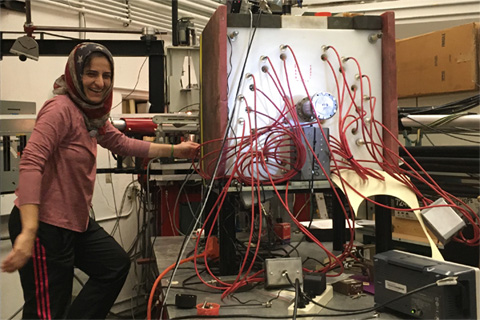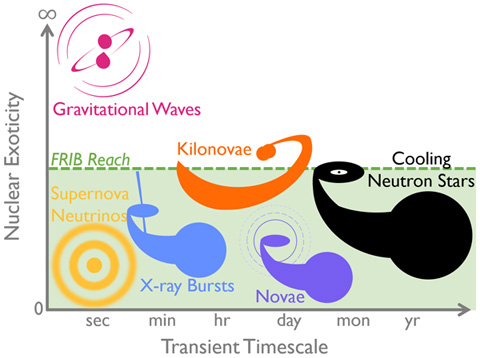Astrophysicist Zach Meisel, Ph.D., is part of an international team of pioneers whose research is delving into the mysteries of the center of the sun and other nuclear infernos that produce the building blocks of the universe.
Their goal is to solve some of the mysteries about stars and stellar burning at the elemental level. Stars are huge fusion reactors, where hydrogen nuclei fuse to create helium and other light elements—and a whole lot of energy—followed by heavier elements on the periodic table.
“Did you ever wonder where the iron and nickel at the center of the Earth’s core came from? Or the oxygen that we breathe? Or the carbon that serves as stored energy in plants and fossil fuels? Look to the stars and you’ll see fiery ovens capable of starting with hydrogen—element #1 on the periodic table—and cooking up the other light elements, first helium, then oxygen, and on through the heavier elements in the iron region on the periodic table. In special scenarios, stars can synthesize elements all the way up to lead,” said Meisel, associate professor of Physics & Astronomy in the College of Arts & Sciences at Ohio University.
Human history is full of tales of magic and alchemy, witches and wizards turning common lead into gold and riches. The English word “alchemy” derives from both Arabic (al-kīmiyā) and ancient Greek (khumeía). Mankind’s wonder at how the elements came to be—and if we can make more of them—has its roots in ancient philosophy as people looked at their world and sought to define its wonders.
Mysteries remain…
For Meisel and his colleagues, there is still much to ponder. They have written a white paper that looks to the future of research into stellar burning. (See “The status and future of direct nuclear reaction measurements for stellar burning” in the Journal of Physics G: Nuclear and Particle Physics.)
And they are about to bring the next generation of nuclear and astrophysical experiments and diagnostic tools to bear on these mysteries:
- What is the carbon/oxygen ratio produced by helium burning?
- And, consequently, where should the upper-mass gap in the black-hole mass distribution be located?
- What is the rate of carbon-carbon fusion, which has downstream implications for type-1a supernova nucleosynthesis and the fate of stars in the 8-10 solar mass range?
- How strong are the neutron sources and sinks within stellar burning?
- And how precisely can neutron-capture yields constrain stellar burning conditions?
Like the ancient philosophers, some of their work will still rely on observations, but now with computers capturing data and crunching it at a rate that Nicolaus Copernicus couldn’t have imagined when he envisioned a model of the universe with the sun at its center.
And in place of the medieval wizard stirring a bubbling cauldron, today’s researchers have a host of new experimental facilities coming online. Even 50-year-old accelerators like the one at Ohio University are being brought to bear on solving some ancient mysteries. In fact, its ion beams and experimental equipment mean it’s uniquely positioned to help get answers to some really important questions about understanding the universe.
“In the past few years, Edwards Accelerator research has demonstrated that the statistical structure of nuclei is inconsistent with theoretical expectations, which may change our understanding of element formation in the universe,” said Meisel, lab director. “In one of our most recent measurements, we found that a nuclear-reaction-based background that was thought to confuse searches for dark matter in the universe has been considerably overestimated until now.”

Ph.D. student Gula Hamad tests the new HeBGB neutron detector at the Edwards Accelerator Laboratory at Ohio University.
New experimental facilities and observatories are anticipated
What is Meisel excited about?
“Underground laboratories are very important for studying stellar burning because you want to get away from the background from cosmic rays coming from space,” he said. “Low-energy studies of thermonuclear reactions in a laboratory at the Earth’s surface are complicated by several sources of background, namely, cosmic rays, environmental radioactivity, and beam-induced nuclear reactions on target impurities. The best solution to attenuate the muon and neutron flux is to install an accelerator facility in a laboratory deep underground, as is also done for solar neutrino detectors.”
Meisel cites three new experimental underground facilities coming online: an upgrade of the Laboratori Nazionali del Gran Sasso (LNGS) in Italy, CASPAR (a mile underground in the former Homestake gold mine in South Dakota) in the United States, and JUNA in China.
“In addition, the facility for rare isotope beams at Michigan State University is going to start producing first science during 2022, and that’s going to allow us to produce radioactive ion beams that we’ve never bene able to make before to study explosive burning,” he said.
Meisel also will be at work here in Athens at the Edwards Accelerator Laboratory. “It’s an older lab, but we’re always developing new detection and analysis techniques that give us new insights into nuclear matter.”
Meisel also is excited about the Vera Rubin observatory under construction in Chile.
“They are going to observe about one-fifth of the visible sky every few nights, and this is going to open up a window into a whole new class of transient objects in the night sky,” he said in a recent podcast interview for Physics World Weekly.
Meisel also points to an international research network for nuclear astrophysicists and the virtual infrastructure, IReNA, that can now link them together more efficiently than ever before.
“That’s going to open up people power in order to approach these stellar burning questions,” he said. The international team’s white paper addresses open questions and the experimental developments of the recent past and near future that will help address them.
For one thing, they hope to peel back the layers of fusion reactions in stars.
“Stars are fusion reactors, and most of this nuclear fusion is going on at the core or around the core. What you basically have at the center of the star is hydrogen converted to helium by various nuclear reactions. Then that helium is burned into carbon and oxygen. And if your star starts out with a mass that’s more than 10 times the mass of the sun, you can continue on to burn heavier elements. So you can burn carbon, neon, oxygen, silicon, and eventually you end up with a core that’s mostly elements around iron. And besides the core burning, you also then have shells of these elements burning, so outside the iron core, there’s silicon and then oxygen, then neon, carbon and so on. And you get this sort of onion-like structure of the star,” Meisel said during the podcast.
How the elements in the universe were made
“One really interesting question is this thing called the upper mass gap for black holes. So when you look at the black hole mass distribution, you find some mass number that’s up for debate, but let’s say around 100 solar masses. You don’t have any black holes that are made around that mass. For those stars, we believe they self destruct as a pair instability supernova. And it turns out where this mass gap happens is related to this reaction known as carbon-12 alpha-gamma, the rate at which carbon and helium are fused to make oxygen.”
Meisel also is interested in the reaction that fuses carbon together, which influences the formation of elements and nuclear synthesis in type 1A supernovae, also known as exploding white dwarf stars.
“This reaction winds up giving us clues as to whether type 1a supernovae are two white dwarfs merging and exploding or one white dwarf siphoning fuel from an ordinary star like the sun. And we need to understand that reaction better if we want to get to the bottom of the problem,” he said.
Meisel notes that making use of data from observatories demands a better understanding of these nuclear reactions. That requires a number of different types of experiments with both direct and indirect measurements.
“The idea behind direct measurements is to try to measure a reaction at the energy that it happens in a star or a stellar explosion. This happens in labs when you aim a beam of particles onto a target and measure what comes out of this collision. But when we can’t do this directly, we do indirect measurements of the important nuclear properties that you need to know in order to calculate an astrophysical reaction. Measuring the mass or studying the structure of a nucleus can help us learn about the structure of the star, the stellar physics, and then also how the elements of the universe were made,” Meisel said in the podcast.
Solar neutrinos, for example, are a diagnostic tool for the temperature and density conditions at the center of the sun. Researchers can observe atomic spectra on the envelopes of stars, and then use these spectra to get elemental abundance patterns.
“And that stellar modeling tells us about how the elements in the universe were made. So we can try to figure out from looking at that pattern, how many supernovae did we have and what did they make. How many neutron star mergers did we have and what did they make?”
Meisel also is a member of the Institute of Nuclear and Particle Physics at Ohio University.





















Comments